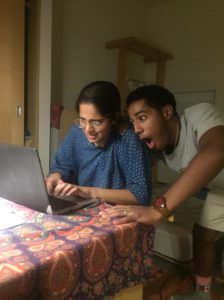 Stuck in a rut? Can’t seem to concentrate on your work? Play Mult, a game tailored to the individual. Before beginning, identify your base task, such as doing your laundry, boiling water for tea, or microwaving food. If there is no base task, click the ‘Just for Fun’ option in the Mult mobile app and set the timer according to your needs.Using the app, create your to do list for the day and assign points to each task. These points should reflect your belief in the underlying difficulty of each task.
Stuck in a rut? Can’t seem to concentrate on your work? Play Mult, a game tailored to the individual. Before beginning, identify your base task, such as doing your laundry, boiling water for tea, or microwaving food. If there is no base task, click the ‘Just for Fun’ option in the Mult mobile app and set the timer according to your needs.Using the app, create your to do list for the day and assign points to each task. These points should reflect your belief in the underlying difficulty of each task.
When you are ready to play, click the ‘START’ button in the app and get to work on completing your tasks. Each time you complete a task, click the specific task in the app (the screen will flash green and a voice should say “congratulations” or “keep it up” or another phrase that provides positive reinforcement.

When the timer runs outs, the screen will flash red and an alarm will go off. When you are done, click the ‘FINISH’ button and the screen will show all the tasks you created and your points/seconds ratio. Your top 3 points/seconds ratio scores will be displayed.

the base task-boiling water for tea
In “gamifying” my play experience, I needed to create elements that clearly made the experience meaningful “play.” I had to create consequences for not ending the tasks within the defined timeframe to have a clear boundary between playing the game and simply going about one’s day. Thus, I added the elements of a timer with an alarm, the positive reinforcements when completing a task, a randomized task list, and the points/seconds ratio. The timer adds conflict for the player and motivates the player to complete the tasks against time and creates a rush. The timer with an alarm conveys to the player that the game is over and they must click the end button or else their score will be lowered through a worse points/seconds ratio. The positive reinforcements in the form of a green flash on screen and statements like “you are amazing” and “keep it up” are designed to reward the player for completing a task and incentivizing the player to complete more.

Having a randomized task list differentiates the game’s tasks from the everyday tasks and creates a dilemma as the player considers the most strategic way to increase his/her score through task completion. Creating a score in the form of the points/seconds ratio allowed me to quantify what the player accomplished so that in subsequent rounds, the player would have a desire to beat their high score and have it displayed on the top scores scoreboard. Creating a score created a clear outcome and a race objective in trying to reduce the time taken to receive a higher score.
Thus, the player’s actions, though completing the same tasks that he/she would in the “real world,” are constrained by a set of rules that simplify his/her actions within the space of play. It is this clear boundary between the game and the ordinary routine, an artificiality that Salen and Zimmerman conclude is central to the definition of the game, that allows this game to be classified as play (Salen 11).
The game does appropriate a space as the ensuing play depends on the context of the player; the conditions of the environment shape what the base task is (whether the player chooses to boil water or to simply play against a timer) and can also shape the tasks the player chooses to do as many of the game elements are derived from elements of the player’s location. For instance, the player may opt to take out the trash, to tidy up shoes, to do the dishes, etc. Thus, a trash can can be appropriated into a prop for the game. As Miguel Sicart summarizes in Play Matters, the player contextualizes a new meaning of the objects within the specific space created by the boundaries of play (Sicart 14).
When my friends played, they did the game at the same time in the same space and thus, distracted each other in the spirit of “racing.” Rather than focusing on getting their tasks done, they tried to prevent each other from accomplishing tasks. Thus, I don’t think Mult would work as a multi-player game unless players had no intersection of environments. Additionally, the game is subjective to the individual as one determines their tasks and the respective point values. One friend gave higher values for similar tasks and thus, had a higher score. Additionally, this quantifiable outcome, even if the game is played at an individual level, is so dependent on the point determination in that particular instance, so in trying to beat one’s score, one simply has to define higher points in the beginning of the game. However, the phrase “cheating yourself” comes to mind as the score is merely one element of the game and rather the game experience is designed with the hope that the player simply breaks out of his/her ordinary routine. Thus, following this playtest, I decided on only making Mult a single player vs. game.

distracting another player writing an email

“racing” to take out the trash.
The game invites creation and expression as one can often find a new way of doing the ordinary within the constraints of the game. The game disrupts the typical routine and the space in which the player operates. However, the player can also lose himself/herself in the need to get tasks done, thus making the game go too far–destruction as a creative force becomes a dangerous one.